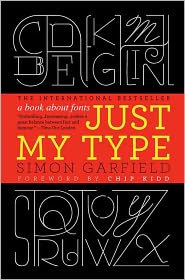 He applied the “Page 99 Test” to his new book, Just My Type: A Book about Fonts, and reported the following:
He applied the “Page 99 Test” to his new book, Just My Type: A Book about Fonts, and reported the following: Page 99 concerns John Baskerville, an 18th Century pioneer whose font you can still select from your pull-down menu. Baskerville worked in Birmingham, England, and he came to type design quite late - he paid his bills by doing lacquer work and engraving headstones. But he was a book lover, and his desire to publish beautiful volumes of Milton and invent new types almost bankrupted him. His books were criticised for being too shiny (not a complaint one hears much today), and they were littered with errors. But he did make one stunning typeface in a variety of styles, and it remains clear, concise and usable for any projects where a traditional mood is required.Learn more about the book and author at Simon Garfield's website.
We can recognise the Baskerville font today by one letter alone: its magnificent Q [inset, left]. I often think of type designers expressing their real creative emotions with their ampersand and their Q, and Baskerville is a prime example.The tail flits a little to the left and then much farther to the right, varying its thickness. It looks rather like a squirrel's tail, and when used today swiftly establishes an air of grandeur and authority.
Page 99 is partly occupied with an illustration of this Q, and with the story of a German fan who had travelled to see Baskerville in 1775, but met with discouraging news: 'Only on my arrival did I learn that he was buried more than six months ago.' We learn that King George III was a big fan of Baskerville's font, and that Baskerville's widow was willing to sell his printing press and all of his metal type for £4,000, something of a bargain.
The page is partly representative of the book as a whole (in so far as it tells a neat story), but the majority of the book is concerned with the history and use of more modern examples, from Futura and Gill Sans to Helvetica and Gotham. Not that Baskerville is a relic. Hilary Clinton used it in her 2008 campaign, and it is still a highly influential classic.
--Marshal Zeringue



